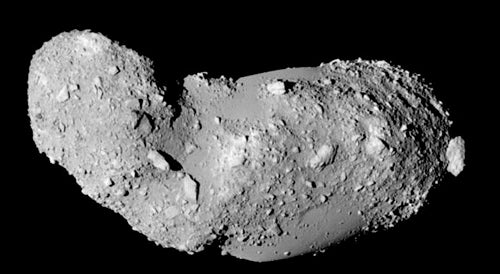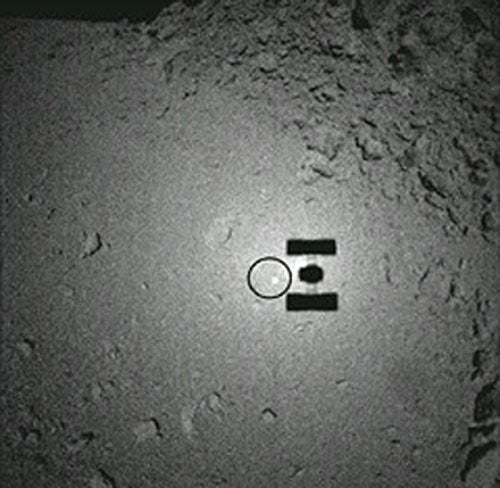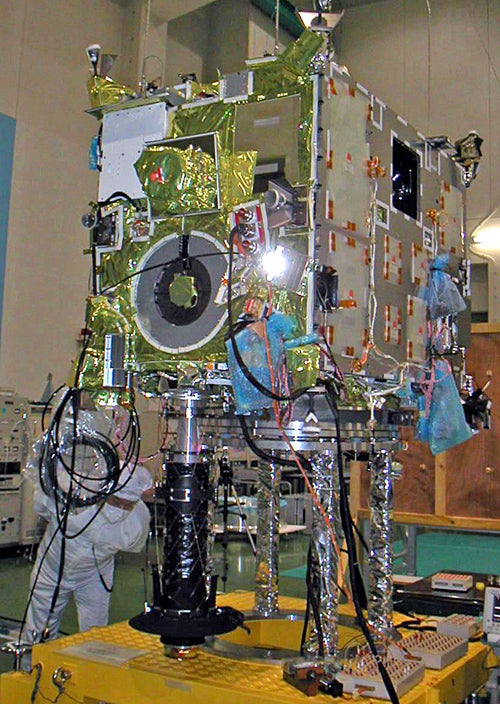Scientists in charge of Japan’s Hayabusa mission believe the craft captured dust from asteroid Itokawa’s surface November 26. If so, this would be the first surface sample collected from a solar system body other than the Moon.
But Japan Aerospace Exploration Agency (JAXA) engineers had little time to celebrate. A few hours after the craft ascended from the asteroid’s surface, it began shaking and briefly lost contact with Earth. Problems with one of the craft’s 12 chemical thrusters continued through Tuesday, according to JAXA. A fuel leak among one set of thrusters caused the shaking, which ceased when controllers closed a fuel valve. In addition, the thrust of maneuvering jets from a separate backup system was smaller than it should be.
Mission controllers, puzzled by these problems, initially speculated the craft may have suffered some damage while on the asteroid’s surface. However, JAXA officials now say the problems are unrelated to the landings. All instuments except the thrusters are in working order, and controllers are trying to resume normal operations. For Hayabusa to return its precious cargo to Earth as planned, the spacecraft must fire up its experimental ion drive and head for home by mid-December.
Since September, Hayabusa (Japanese for falcon) has been hovering above the asteroid’s boulder-strewn surface like a raptor circling its intended prey. From this perch, it has studied the rock with cameras, near-infrared and X-ray spectrometers, a laser altimeter, and more. Potato-shape (25143) Itokawa, an S-type asteroid, is about 1,800 feet (550 meters) long and now lies 180 million miles (290 million kilometers) from Earth. It’s named for Japanese rocket pioneer Hideo Itokawa.
Hayabusa’s images reveal Itokawa is an asteroid like none other seen so far. Most of its surface is covered with rocky boulders and giant rock splinters — there’s not an obvious impact crater in sight. Scientists believe Itokawa is a “rubble-pile” asteroid — a loose collection of fractured rock and dust. They informally named one smooth, dusty region Muses Sea, a nod to Hayabusa’s earlier designation (MUSES-C).
On November 26, at 7:35 a.m. Japan Standard Time, the spacecraft briefly alighted on the asteroid’s surface. Sensors detected when the probe’s funnel-like sample-collection horn touched down, which triggered a mechanism that fired two pellets made of tantalum. Ejecta from the pellet impacts forced a few grams of surface material up the horn, where they were placed into storage.
“This ‘touch-and-go’ sampling technique is designed to take advantage of the asteroid’s low gravity, rather than trying to fight it with a surface-landing spacecraft,” says Don Yeomans, U.S. project scientist for the mission and a senior scientist at the Jet Propulsion Laboratory in Pasadena, California.
The ambitious space mission has experienced more than its share of setbacks since its May 9, 2003, launch from Japan’s Kagoshima launch complex. In October and November 2003, it rode out some of the most intense solar flares on record. This July, one of the probe’s three reaction wheels — devices that help the spacecraft maintain a given orientation — stopped working, and Hayabusa lost a second one in October.
Controllers attempted a sample-collection run November 19, but communication problems led controllers to believe Hayabusa aborted its descent. Later analysis showed it touched the surface, bounced once, and settled onto Itokawa for 30 minutes before an emergency command from Earth instructed it to move. Unfortunately, Hayabusa had not been placed in sampling mode at the time it touched down. It did release a target marker designed to help the spacecraft limit lateral motion near the surface. The marker contained 880,000 names of space enthusiasts from 149 countries who submitted their names over the Internet.
The ultimate success of Hayabusa’s sampling helped take the sting out of its rocky mission. It also put some past JAXA failures into perspective, such as the Mars orbiter Nozomi, which was unable to slow into orbit and sailed past the planet in 2003.
“The success of Hayabusa has become a tailwind for Japan’s space development,” says Hajime Inoue, JAXA’s executive director. “It proves that the way we have been doing things wasn’t wrong.”
If controllers can get Hayabusa on its way, the spacecraft is scheduled to arrive at Earth in June 2007. It will then release a sample-return capsule, which will enter Earth’s atmosphere and parachute its cargo onto the Australian outback, where anxious scientists will be waiting.












